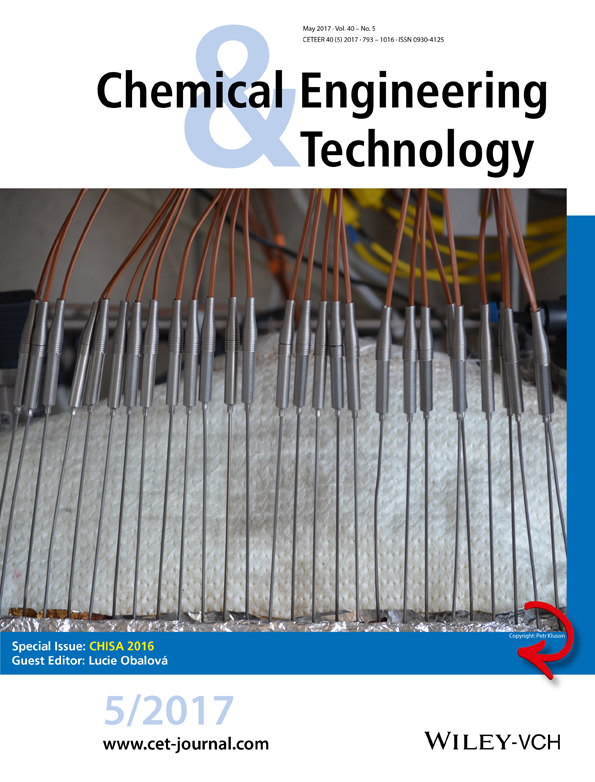Effect of Copper-based Catalyst Support on Reverse Water-Gas Shift Reaction (RWGS) Activity for CO2 Reduction
Damjan Lašič Jurković
National Institute of Chemistry, Department of Catalysis and Chemical Reaction Engineering, Hajdrihova 19, 1000 Ljubljana, Slovenia
Search for more papers by this authorCorresponding Author
Andrej Pohar
National Institute of Chemistry, Department of Catalysis and Chemical Reaction Engineering, Hajdrihova 19, 1000 Ljubljana, Slovenia
Correspondence: Andrej Pohar ([email protected]), Department of Catalysis and Chemical Reaction Engineering, National Institute of Chemistry, Hajdrihova 19, 1000 Ljubljana, Slovenia.Search for more papers by this authorVenkata D. B. C. Dasireddy
National Institute of Chemistry, Department of Catalysis and Chemical Reaction Engineering, Hajdrihova 19, 1000 Ljubljana, Slovenia
Search for more papers by this authorBlaž Likozar
National Institute of Chemistry, Department of Catalysis and Chemical Reaction Engineering, Hajdrihova 19, 1000 Ljubljana, Slovenia
Search for more papers by this authorDamjan Lašič Jurković
National Institute of Chemistry, Department of Catalysis and Chemical Reaction Engineering, Hajdrihova 19, 1000 Ljubljana, Slovenia
Search for more papers by this authorCorresponding Author
Andrej Pohar
National Institute of Chemistry, Department of Catalysis and Chemical Reaction Engineering, Hajdrihova 19, 1000 Ljubljana, Slovenia
Correspondence: Andrej Pohar ([email protected]), Department of Catalysis and Chemical Reaction Engineering, National Institute of Chemistry, Hajdrihova 19, 1000 Ljubljana, Slovenia.Search for more papers by this authorVenkata D. B. C. Dasireddy
National Institute of Chemistry, Department of Catalysis and Chemical Reaction Engineering, Hajdrihova 19, 1000 Ljubljana, Slovenia
Search for more papers by this authorBlaž Likozar
National Institute of Chemistry, Department of Catalysis and Chemical Reaction Engineering, Hajdrihova 19, 1000 Ljubljana, Slovenia
Search for more papers by this authorAbstract
Cu-based bifunctional materials were examined for carbon dioxide conversion, thus producing the syngas from hydrogen, which can be attained using surplus electrical energy. Catalysts were synthesized by deposition-precipitation fabrication method, i.e., copper on Al2O3, CeO2, SiO2, TiO2, and ZrO2. To investigate chemical reaction kinetics, the turnover was screened in a parallel high-throughput packed-bed reactor system. The results indicated that catalytic pathway mechanisms were affected by the substrate. An optimal supporting oxide may thus contribute to the engineering and intensification of unconventional feedstock processing, e.g., CO2, as well as the design of emerging catalysis routes. The produced synthesis gas may be readily used for basic chemical platforms, such as methanol.
Supporting Information
| Filename | Description |
|---|---|
| ceat201600594-sup-0001-misc_information.pdf2.9 MB | Supplementary Information |
Please note: The publisher is not responsible for the content or functionality of any supporting information supplied by the authors. Any queries (other than missing content) should be directed to the corresponding author for the article.
References
- 1 A. Wolf, A. Jess, C. Kern, Chem. Eng. Technol. 2016, 39 (6), 1040–1048. DOI: 10.1002/ceat.201500548
- 2 E. Schwab, A. Milanov, S. A. Schunk, A. Behrens, N. Schödel, Chem. Ing. Tech. 2015, 87 (4), 347–353. DOI: 10.1002/cite.201400111
- 3 M. J. L. Ginés, A. J. Marchi, C. R. Apesteguía, Appl. Catal., A 1997, 154 (1–2), 155–171. DOI: 10.1016/S0926-860X(96)00369-9
- 4 F. Stone, D. Waller, Top. Catal. 2003, 22 (3), 305–318. DOI: 10.1023/A:1023592407825
- 5 C. Álvarez, J. Schumann, M. Behrens, J. Luis, G. Fierro, R. Schlögl, E. Frei, Appl. Catal., B. 2016, 195, 104–111. DOI: 10.1016/j.apcatb.2016.05.007
- 6 F. Meshkani, M. Rezaei, Chem. Eng. Technol. 2015, 38 (8), 1380–1386. DOI: 10.1002/ceat.201400668
- 7 P. K. Kiyohara, H. S. Santos, A. C. V. Coelho, P. de Souza Santos, An. Acad. Bras. Ciênc. 2000, 72 (4), 471–495. DOI: 10.1590/S0001-37652000000400003
- 8 P. Periyat, F. Laffir, S. A. M. Tofail, E. Magner, RCS Adv. 2011, 1, 1794–1798. DOI: 10.1039/c1ra00524c
- 9 Y. Wang, H. Zhang, Y. Han, P. Liu, X. Yao, H. Zhao, Chem. Commun. 2011, 47, 2829–2831. DOI: 10.1039/c0cc04848h
- 10 A. Di Paola, M. Bellardita, L. Palmisano, Catalysts 2013, 3 (1), 36–73. DOI: 10.3390/catal3010036
- 11 Y. Zhang, Z. Su, B. Liu, G. Li, Powder Technol. 2016, 291, 337–343. DOI: 10.1016/j.powtec.2015.12.048
- 12 S. M. Pudi, P. Biswas, S. Kumar, B. Sarkar, J. Braz. Chem. Soc. 2015, 26 (8), 1551–1564. DOI: 10.5935/0103-5053.20150123
- 13 R. Mehdizadeh, L. A. Saghatforoush, S. Sanati, J. Chin. Chem. Soc. (Taipei) 2013, 60 (3), 339–344. DOI: 10.1002/jccs.201200419
- 14
M. Kosmulski, Chemical Properties of Material Surfaces, CRC Press, Boca Raton, FL
2001.
10.1201/9780585418049 Google Scholar
- 15 J.-P. Jolivet, Metal Oxide Chemistry and Synthesis: From Solution to Solid State, John Wiley & Sons, Chichester 2000.
- 16 H. Y. Kim, P. Liu, ChemCatChem 2013, 5 (12), 3673–3679. DOI: 10.1002/cctc.201300449
- 17 Y. A. Daza, J. N. Kuhn, RSC Adv. 2016, 6 (55), 49675–49691. DOI: 10.1039/C6RA05414E
- 18 C. S. Chen, J. H. Lin, J. H. You, C. R. Chen, J. Am. Chem. Soc. 2006, 128 (50), 15950–15951. DOI: 10.1021/ja063083d
- 19 S. S. Kim, H. H. Lee, S. C. Hong, Appl. Catal., B 2012, 119–120, 100–108. DOI: 10.1016/j.apcatb.2012.02.023
- 20 B. Chamnankid, K. Föttinger, G. Rupprechter, P. Kongkachuichay, Chem. Eng. Technol. 2014, 37 (12), 2129–2134. DOI: 10.1002/ceat.201300869
- 21 L. Jiang, C. Li, Z. Li, S. Zhang, Chem. Eng. Technol. 2013, 36 (11), 1891–1898. DOI: 10.1002/ceat.201300425
- 22 Y. A. Daza, J. N. Kuhn, RSC Adv. 2016, 6, 49675–49691. DOI: 10.1039/C6RA05414E
- 23 M. Kovacevic, B. L. Mojet, J. G. Van Ommen, L. Lefferts, Catal. Letters 2016, 146 (4), 770–777. DOI: 10.1007/s10562-016-1697-6
- 24 O. Hernández-Cristóbal, G. Díaz, A. Gómez-Cortés, Ind. Eng. Chem. Res. 2014, 53 (24), 10097–10104. DOI: 10.1021/ie501283c
- 25 D. Martin, D. Duprez, J. Phys. Chem. 1996, 100 (22), 9429–9438. DOI: 10.1021/jp9531568
- 26 K.-H. Ernst, C. T. Campbell, G. Moretti, J. Catal. 1992, 134 (1), 66–74. DOI: 10.1016/0021-9517(92)90210-9




